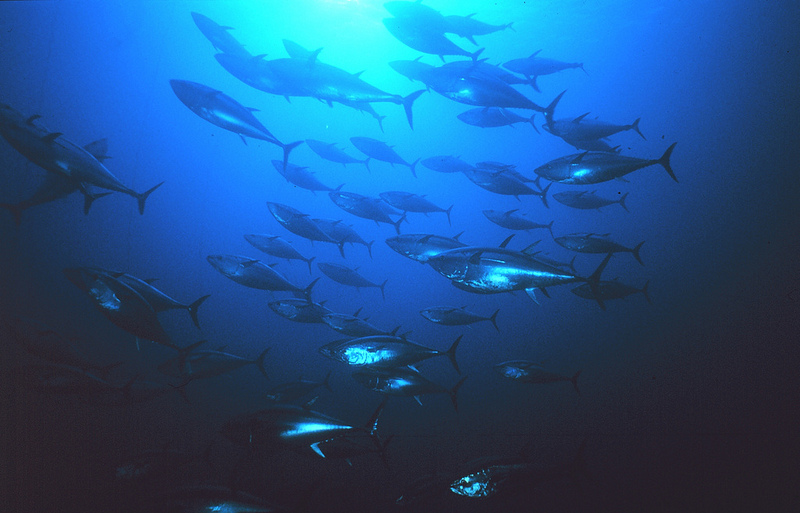- A new report by WWF and the Zoological Society of London (ZSL) released last week finds that fish populations targeted by fisheries dropped by 50 percent between 1970 and 2010.
- The report found that overall, populations of marine vertebrates (mammals, birds, reptiles, amphibians, and fish), including non-targeted populations, fell by 49 percent in 40 years.
- Around 3 billion people depend on seafood as a primary source of protein. Fishing and aquaculture also support around 10 to 12 percent of the world’s population, according to the report.
Industrial fisheries have depleted our oceans in just a few decades, according to a stark new report by WWF and the Zoological Society of London (ZSL). Released last week, the Living Blue Planet Report finds that fish populations targeted by fisheries dropped by 50 percent between 1970 and 2010. Some fish, such as members of the Scrombidae family, which includes tuna, mackerel, and bonito, fell by a shocking 74 percent.
“The picture is now clearer than ever: humanity is collectively mismanaging the ocean to the brink of collapse,” writes Marco Lambertini, the Director General of WWF International, in the report’s introduction.
Not only does this decline in marine fish mean a complete transformation of the ecology of many of the world’s marine environments, but it also puts billions of people’s livelihoods and food security at risk. Around 3 billion people depend on seafood as a primary source of protein. Fishing and aquaculture also support around 10 to 12 percent of the world’s population, according to the report.
“When we look at the fish species most directly tied to human well-being — the fish that constitute up to 60 per cent of protein intake in coastal countries, supporting millions of small-scale fishers as well as a global multibillion-dollar industry — we see populations in a nosedive,” Lambertini writes. “The habitats they depend on, such as coral reefs, mangroves and seagrasses, are equally threatened.”
Some marine-animal populations have totally collapsed. Sea cucumber populations fell by over 90 percent in both the Galapagos and the Red Sea in order to feed demand as a luxury item in Asia. Meanwhile, overfishing has also put a quarter of the world’s shark, ray, and skate populations at risk of extinction.

But it’s not only targeted species. The report found that overall, populations of marine vertebrates (mammals, birds, reptiles, amphibians, and fish), including non-targeted populations, fell by 49 percent in 40 years. For example, all but one of the world’s seven sea turtle species are listed as threatened with extinction by the IUCN, meaning they fall into the Vulnerable, Endangered, or Critically Endangered categories. The one species that isn’t — the flatback sea turtle (Natator depressus) — is considered Data Deficient, meaning scientists don’t have enough information to categorize it. (While some sea turtles face pressure from people collecting their eggs, the animals are not generally targeted at other life stages.)
Meanwhile, more than a quarter (28 percent) of the world’s seabirds are currently threatened with extinction, according the IUCN Red List as well. This is a percentage twice as high as land birds.
“This report suggests that billions of animals have been lost from the world’s oceans in my lifetime alone. This is a terrible and dangerous legacy to leave to our grandchildren,” said Ken Norris, the Director of Science at ZSL in a press release announcing the new report.
Covering a total of 1,234 vertebrate species in 5,829 distinct populations, the Living Blue Planet Report claims to work from the largest dataset amassed up till now on the state of wildlife in the oceans. Yet, according to Callum Roberts, a marine conservation biologist at the University of York in the U.K., the new report actually underreports the oceans crisis.
“Although 1970 is their baseline year and seems long ago, life in the sea has been in decline for much longer. In short, that means the picture is worse than the report suggests,” Roberts writes in the Observer.
The WWF and ZSL report focuses mostly on overfishing, but notes that marine life has also been impacted by the destruction of habitats, pollution (from plastics and fossil fuel exploitation, for example), tourism, climate change, and ocean acidification.
“[Climate] impacts on key marine and coastal organisms, ecosystems, and services are already detectable, and several will face a high risk of impacts well before 2100, even under the low-emissions scenario,” reads the report.
On the plus side, the report says that a slew of solutions currently exist to the problem of widespread ocean degradation. “It’s not too late to save our seas: opportunities and solutions exist for governments, business and industry, and civil society to rise to the challenge,” the report states.
Solutions include establishing more marine protected areas (MPAs, as they are called, currently cover less than 4 percent of the world’s oceans and few of these ban fishing outright), pushing for more local community management of marine areas, expanding sustainable-seafood certification programs like the Marine Stewardship Council and the Aquaculture Stewardship Council, eliminating harmful subsidies and unsustainable investment practices, and, of course, rapidly cutting greenhouse-gas emissions. Consumers have a role, according to the report, by supporting sustainably caught seafood.
“The ocean is an integral part of our lives. We are kept alive by the clean air, food and other services it provides. More than that, we are simply drawn to the ocean and its wildlife,” said Norris.
Citations:
- WWF (2015). Living Blue Planet Report. Species, habitats and human well-being. Tanzer, J., Phua, C., Lawrence, A., Gonzales, A., Roxburgh, T. and P. Gamblin (Eds). WWF, Gland, Switzerland.